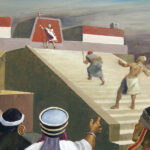The story of the Kinderhook Plates is one of the most debated episodes in the history of Joseph Smith and the Church of Jesus Christ of Latter-day Saints. The plates, which were later revealed to be a hoax, have been used by critics as evidence that Smith was unable to discern between authentic and fraudulent artifacts. But did Joseph Smith actually translate the Kinderhook Plates, or was his involvement more limited? Examining the historical statements surrounding this event suggests that it is unlikely that Smith attempted to formally translate them.
The Discovery of the Kinderhook Plates
In 1843, a group of men in Kinderhook, Illinois, claimed to have unearthed six bell-shaped plates inscribed with ancient-looking characters. The plates were quickly taken to Joseph Smith, who was renowned for translating ancient records, including the Book of Mormon. The discovery was reported in the Times and Seasons, an LDS newspaper, with excitement about the possibility of the plates being a genuine record of an ancient people. However, the plates were later revealed to be a deliberate forgery, created by Wilbur Fugate and other men who wanted to trick Smith into translating them.
The Question of Translation
For years, the primary evidence that Smith translated the Kinderhook Plates has been a journal entry from William Clayton, one of Smith’s scribes. On May 1, 1843, Clayton recorded:
“I have seen six brass plates… President Joseph has translated a portion of them, and says they contain the history of the person with whom they were found. He is a descendant of Ham through the loins of Pharaoh, king of Egypt.”
This statement is often cited as evidence that Smith translated at least part of the plates. However, upon closer examination, it becomes clear that Clayton’s journal entry does not necessarily mean Smith engaged in a formal translation process. Instead, it is possible that Smith merely speculated about the plates’ origin based on his previous work with Egyptian texts.
Did Smith Actually Translate the Plates?
According to Don Bradley and Mark Ashurst-McGee, as discussed in the BYU Religious Studies Center essay “Did Joseph Smith Translate the Kinderhook Plates?”, the historical record does not support the idea that Smith conducted a serious translation. Instead, the evidence suggests that Smith may have made a brief examination of the plates and possibly compared them to his earlier Egyptian study materials—specifically, his “Grammar and Alphabet of the Egyptian Language” (GAEL).
Bradley and Ashurst-McGee argue that Smith’s alleged translation was based on an assumption rather than a revelatory process. If Smith had genuinely believed the plates were an authentic ancient record, he likely would have pursued a more formal and public translation effort, as he did with the Book of Mormon and the Book of Abraham. The lack of any written translation from Smith himself further supports the idea that he did not take the plates seriously.
The Hoax Revealed
In 1879, Wilbur Fugate, one of the original forgers, admitted that the Kinderhook Plates were a hoax. He explained that they were created using acid and inscriptions meant to mimic an ancient script. The plates were designed specifically to test Smith and expose him as a fraud if he attempted to translate them.
Later, in 1980, metallurgical tests confirmed that the plates were not ancient, further solidifying that they were a 19th-century fabrication. If Smith had indeed translated any portion of the plates, it would have meant he was translating a modern forgery, casting doubt on his ability to discern authentic ancient texts.
Conclusion: A Lack of Translation
While it is true that Smith expressed interest in the Kinderhook Plates, the available evidence does not support the idea that he conducted a serious translation. The claim that he translated a portion of the plates comes not from Smith himself, but from secondhand reports, specifically from William Clayton’s journal entry. Additionally, there is no surviving written translation, and Smith never produced a full revelation regarding the plates. Given these factors, it is more likely that Smith made a speculative comment rather than a definitive translation attempt.
The Kinderhook Plates remain an interesting episode in LDS history, but they do not provide conclusive evidence that Joseph Smith engaged in a fraudulent translation process. Instead, they highlight the importance of carefully examining historical sources and understanding the context in which Smith made his remarks. As more scholars continue to analyze the documents surrounding this event, the consensus remains: Smith likely did not translate the Kinderhook Plates in any meaningful way.





